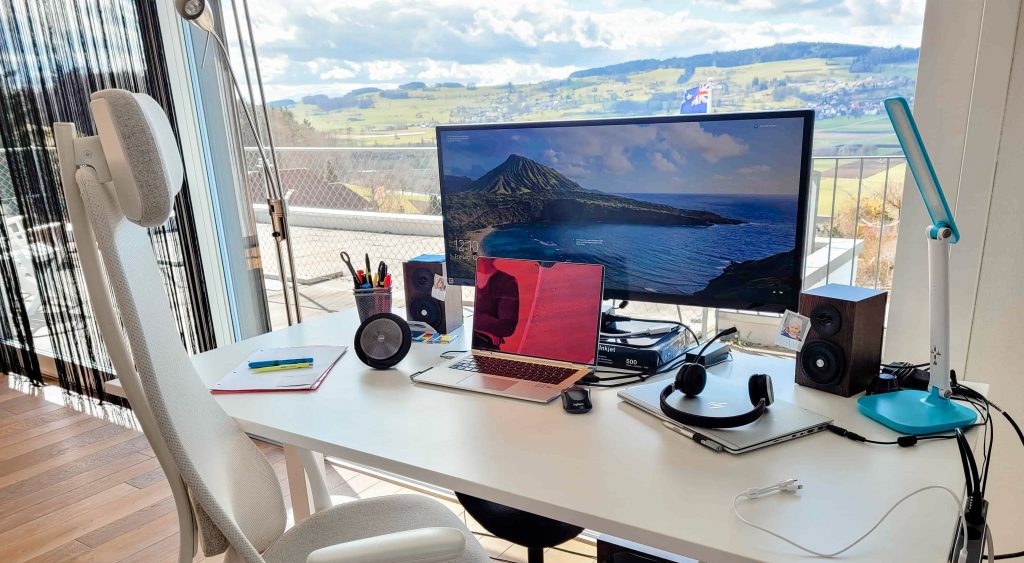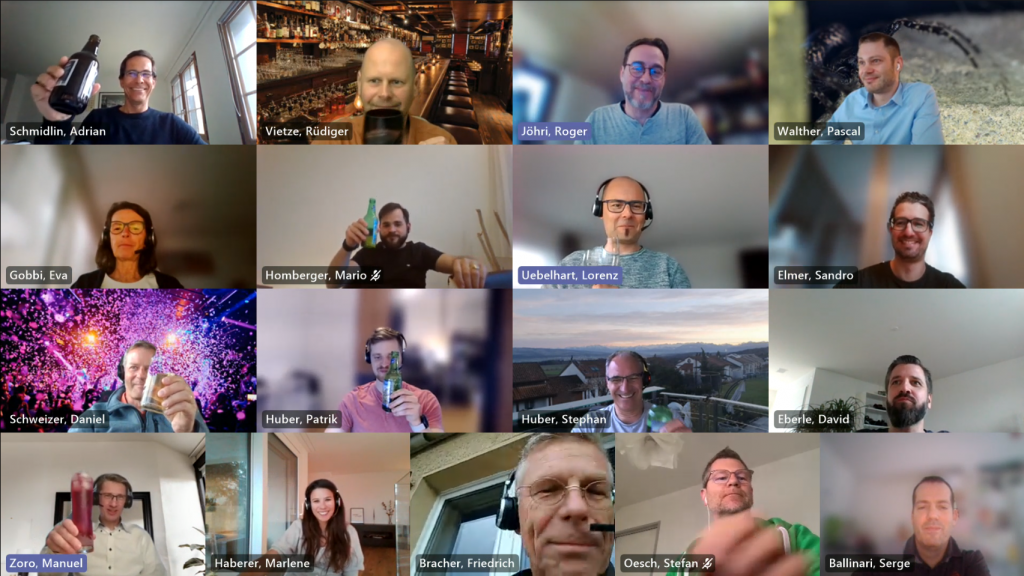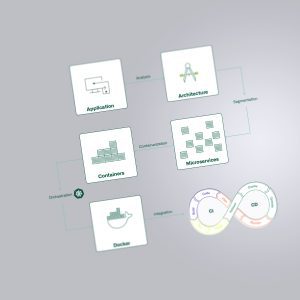Company
March 19, 2021
atrete Insight 2021
Life with Corona
I could never have imagined that one year after the first lockdown, Corona would still be restricting our freedoms, determining our lives and will continue to do so for the time being. That is why we are focusing on this pandemic and all the changes it has brought to our working lives.
We in IT must provide the necessary structures so that employees in all roles have the right environment in which to work, not only in the office, but also with a focus on the now obligatory home office. I wish you an exciting read with atrete Insight and continued patience and perseverance in overcoming the challenges created by Corona.
Best regards,
Michael Kaufmann, CEO and Managing Partner, atrete

Covid-19 and the CIO: the impact of a pandemic
Digitization: Emergency exercise or paradigm shift
If Covid-19's impact on digitization is the equivalent of a wildfire, then the CIO has been on the front lines as the fire extinguisher.
Within a few weeks, sometimes even within days, a concept for replacing office operations with home offices had to be created, implemented and adapted during ongoing operations. The task was to contain the wildfire of needs and bring it under control. The top priority was mobile devices, remote access and collaborative solutions and - very centrally - the recalibration of the central resources in the network, which were loaded differently by the differently structured traffic. While this was often feasible in pure service companies without significant additional effort, the manufacturing industry in particular was exposed to strong challenges. A workstation in production and warehousing, or even a terminal, could not simply be replaced by a corresponding laptop from remote - quite apart from the fact that many processes are effectively only possible with the local presence of the employee.
In our view, the "digital impact" of the pandemic on our day-to-day operations can be summed up as follows after the first few months:
- The shift to working as far away from home as possible has, by and large, been successful for the economy.
- The most significant change for most employees is the widespread use of video conferencing. However, the impact of the switch to remote and digital tools is a noticeable slowdown in communication and unfortunately leads to a lower efficiency of meetings.
- With the exception of the more widely used video conferencing, the actual digitisation is not affected, as the operational processes are maintained in the status quo in the first phase so as not to jeopardise stability.
Unfortunately, it must be assumed that the current situation will not change as quickly as expected. At the same time, many companies are affected by drastic economic conditions and project portfolios are being streamlined again and again. This presents the CIO with the challenge of having to set priorities on a permanent and situational basis. What was valid yesterday is no longer valid today, and what will be valid tomorrow is uncertain. In order to maintain the analogy of the wildfire, the task now is to identify and extinguish the embers.

In the medium term, pragmatic recommendations for action are crystallising for digitisation, which are deliberately intended to have a major impact with a small economic outlay:
Optimize key tools
Seek targeted user input from the experience of the initial, rapid transition to remote operations. In addition to service delivery, the CIO and his team also take on the role of coaches for the tools that address the bulk of operational needs. Create a remote work board to effectively engage stakeholder interests.
Usage policy for video conferencing
Support the development of a usage policy for video conferencing, if necessary together with HR. It must be possible to compensate for the media-related slowness of the tool by specifically increasing the communication discipline and the quality of the preparation.
Digitize with little effort
Look specifically for quick wins in the processes that have already been digitized. Which application breaks can be digitized with little effort? Which data transfers only require a small amount of effort to create or optimize interfaces in order to be made more consistent?
The long-term perspective of digitization projects is, even more than the medium-term, uncertain and difficult to plan in terms of feasibility. Due to the low predictability of the overall economic situation, digitization projects are subject to the general project stop for projects that are not immediately essential for survival. Under certain circumstances, this can lead to a serious innovation backlog that impairs the competitive position of the company concerned.
The new role of the CIO
ICT is transforming into a strategic factor for business survival. The modern CIO is taking on a more significant role in business management. This includes:
- By clearly presenting the networking aspects of digitization and the process map, identify the core projects that need to be addressed in the first rank and that are strategic across the company. This also secures the necessary human and financial resources.
- Outside of the strategic projects, to provide the management with decision support for prioritization by permanently assessing the ROI of digitization projects. Quick wins are essential - but only if they are identifiable.
- Implementing business processes even better with IT resources through strategic business alignment. Existing tools should be functionally exhausted and functional gaps can be closed efficiently. The step from IT architecture to enterprise architecture is a lengthy one - but if it is applied with a focus on the core processes with the highest added value, the ROI is most quickly visible.
For further information:
The Corona pandemic is affecting the entire economy - and digital transformation can give you the competitive edge you need to survive. Use your and our initial experiences from the crisis in medium- and long-term plans. atrete is happy to support you.
Home office: how do companies support their employees efficiently?
While Corona has greatly changed business operations and work environments, it has also accelerated trends such as the home office, which have already appeared at some of the largest global companies. The pandemic has also made smaller or mid-sized companies realize the benefits and now offer these options.
In addition, the home office obligation imposed by the federal government as a measure in the Corona crisis currently obliges every employer to offer home office if there are no valid reasons against it. For many companies, this was new territory and they were forced to adapt to it. You can find out here which technical, organisational and cultural aspects need to be taken into account.

Home office must be user-friendly and secure
Corona has shown that efficient home office working can work - with the right Digital Workplace implementation.
To enable a cohesive Digital Workplace environment, tools should be easy to use, ensure security, and integrate seamlessly with other productivity tools so that employees have a consistent, enjoyable experience with the tools they use every day.
In addition to the Digital Workplace environment, the social and cultural aspects play an important role in performing work from home. When these two areas are lived by the companies, the employee gets a positive home office experience.
With now one year of home office experience for atrete employees, we reveal our best practice tips for working in a home office divided into the following topics:
1. Technical requirements
2. Collaboration tools
3. The workplace
4. Social and cultural aspects
1. the technical requirements
Internet: Whether work is done at home, in the office, or on the road, a fast and stable internet connection is essential. It can be very frustrating to have an unreliable connection.
Computer: A computer with sufficient RAM (>8GB) and SSD hard disk with at least 512 GB memory is recommended. A notebook is an advantage and increases the flexibility of the workplace. If your company has a virtual desktop solution, the company applications can also be accessed via the private computer.
Multimedia: If the computer does not have a good built-in camera, there are good external USB cameras. In times of virtual meetings, the cameras increase a better meeting quality. To get a good audio quality you should not use the integrated audio solutions of the computer if possible. The quality is noticeably worse than a USB headset certified for the collaboration solution used. If you participate in virtual meetings for a long time every day and your workplace allows it, a certified handsfree headset is recommended. Well-known brands are Jabra, Poly, Sennheiser, Yealink or Logitech.
Screen & keyboard: An external monitor with a good size (min. 27") is highly recommended to get a good overview of your work. Position the monitor so that you are not disturbed by window glare. A wireless mouse and keyboard complement an external monitor, which also makes work easier.
Docking Station: Supports the connection of peripheral devices so that only one cable connection is required to the computer. Nowadays it is also available integrated in a monitor.
atrete supports its employees by setting up the technical home office infrastructure with the following IT components:
- HP notebook with integrated camera
- Jabra headset
- Wireless Logitech Mouse
- 27″ Samsung screen from the office employees may take home with them
2. collaboration tools
These are the most important communication tools to communicate in the virtual world. Effective communication is the basis for the success of a company. There are countless solutions that enable video conferencing with up to several hundred participants. Often, the solutions also offer chat services that enable the exchange of data.
Utilize channels such as chat, audio, video or online meetings and be sure to turn on the camera during video meetings. It may well take a bit of a culture change but the camera makes for a better quality meeting and it increases the focus in the session.
For more than 2 years, atrete has been using the Microsoft O365 collaboration solution. The company's strategy was to replace the aging on prem infrastructure with the cloud solution from Microsoft. Fortunately, this meant that atrete was well equipped for home office work. Since Corona has forced us to work in a home office, Microsoft Teams has been the leading tool for atrete to exchange information internally or with our clients.
3. the working environment
Workplace: Make sure that you have a quiet retreat where you can work undisturbed and in peace. If you don't have a separate room, a professionally furnished alcove can also be good for a home office.
Work table and chair: According to SUVA guidelines, the elbow height should be approximately the same as the table height. If you do not have a height-adjustable desk, at least the chair should be adjustable in height so that you can adjust the elbow height. When buying an office chair, make sure it has good basic features.
4. social and cultural aspects
Daily structure: Create a home office work structure with working hours and breaks. Breaks are important and often come too short in the home office. If the working hours differ greatly from the company standards, inform your supervisor.
Work-Life Balance: If you work from home, the work-life balance is a little unclear. Is home my office or is the office my home? If you are always at home and in your home office, do you often feel like you are working? Finding work-life balance is a big challenge when you work from home. Create a family rule to separate work and family as much as possible. Also make sure that your health is not neglected and that you exercise several times a day and don't spend the whole day in your home office.
Continuing Education with Online Training: Learning doesn't always have to take place in a classroom. There are many good eLearning courses for organizations and individuals that can be used immediately.
Social meetings like Virtual Coffee Break or Virtual Apéro Break: It's not the same as coffee at 9 a.m. or a beer after work, but it helps a bit to talk about non-work-related topics in the team and not to lose social contact. These meetings are also important for new employees to quickly find the connection in the team.
Sharing knowledge and experience with employees: In the past, knowhow and experiences were often shared in discussions at the workplace. This sharing of knowledge is important for the company. Set a fixed date for such know-how transfer meetings.

Support from the employer
Companies should support their employees by providing guidelines, standards or even regulations regarding working in a home office. Examples could be the following points:
- How does the company support the employee in terms of IT hardware/software and access to company data and applications?
- What security guidelines must the employee follow in the home office?
- Home office guidelines and best practice tips for employees.
- Online training courses for application use or work behaviour in the home office.
How atrete can support your business:
- Recording needs and requirements incl. creation of use cases, user stories and personas
- Creation of a medium and long-term workplace and/or collaboration strategy
- Creation of a policy / user guideline for home office activities
- Tendering and evaluation of a suitable solution for your company
- Management of implementation projects
For further information:
For home office to work, it requires not only innovations and new technologies - but also a cultural change in the company. Working from home shows how important a high-quality and comprehensive collaboration solution is for your company. atrete is happy to support you with agile.





